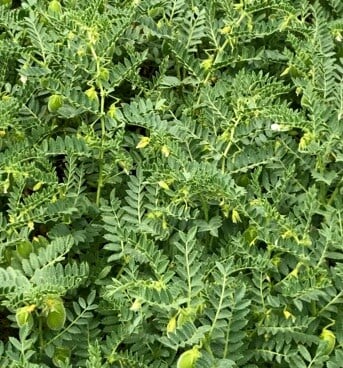Pulse agronomy field day review (Bundalong)
At a 2022 pulse field day in Bundalong, speakers tackled spring disease issues and upcoming harvest challenges in faba beans.

Disease and harvestability were the hot topics at the GRDC, FAR Australia and Brill Ag Pulse Agronomy Field Day, on 28 October at Bundalong. The wet conditions in Daysdale resulted in just the one field day being delivered in Bundalong, however results to date from both trial sites were presented.
The day was well received by 35 local agronomists and farmers from the region. Speakers included Ben Morris and Tom Price (FAR Australia) and Rohan Brill (Brill Ag).
Discussions highlighted the outbreak of chocolate spot, particularly in the past few weeks, even with robust fungicide programs in place. The outbreak of chocolate spot, coupled with waterlogged conditions have reduced yield expectations for faba bean crops in the region. Harvesting beans will also be challenging, because the crops have fallen over (lodged). The group discussed whether to windrow beans; this may have several advantages, however one of the main disadvantages includes rainfall soon after windrowing, which could lead to mould developing in the rows.
The GRDC’s Pulse Agronomy investment is designed to close the economic yield gap and maximise the farming system benefits from grain legume production. In the low disease year of 2021, there were yield responses at Buraja (2021 NSW site) to fungicide in PBA Bendoc, but not in PBA Amberley, which reflects difference in genetic resistance to disease. At the Bundalong site, disease levels were low and there were no yield responses to the application of fungicide in PBA Samira in 2021. The 2022 season has been the opposite, and the trials will provide some good information on best bet fungicide programs.
Despite some disappointment in disease levels in commercial faba bean crops, most agronomists were pragmatic about the benefits faba beans will provide the farming system. There was an estimated 15-17 t/ha of above ground biomass in the best trial plots, which potentially (with good nodulation) could fix 350-400 kg/ha nitrogen and boost grain crops for the next 2-3 seasons.
The key points for growing a hyper yielding faba bean crop are: well applied inoculant, good plant density, variety selection, a robust fungicide program and sowing early enough to grow sufficient biomass (14t/ha) at harvest.
Source: FAR Australia, FIELD DAY -BUNDALONG HANDOUT, Friday 14th October 2022.
The Field Day Booklet can be sourced at:
221014_Bundalong-Pulse-Field-Day-Booklet_FINAL.pdf (faraustralia.com.au)
221014_Daysdale-Pulse-Field-Day-Booklet_FINAL.pdf (faraustralia.com.au)
Author
NEWS
Catch up on our latest project and event news.
-
Livestock
-
People
-
Grains
-
Sustainability

